Litchi : A Sweet Superfruit With Powerful Benefits
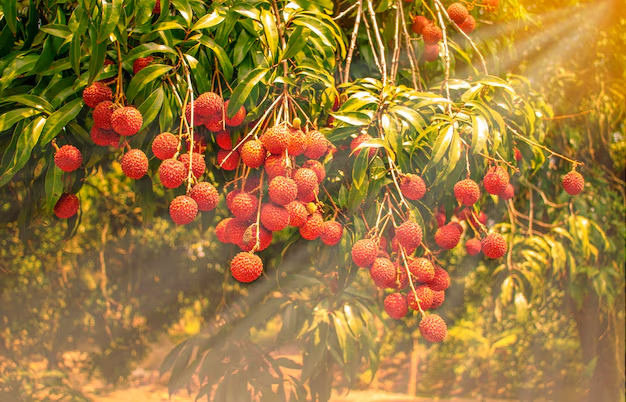
Introduction
Litchi (Litchi chinensis), often spelled as lychee, is a tropical and subtropical fruit known for its juicy, aromatic flavor and a texture that’s a cross between a grape and a pear. Native to the Guangdong and Fujian provinces of China, the litchi has been cultivated for over 2,000 years and is revered not only for its unique taste but also for its medicinal and nutritional properties.
Today, litchi is enjoyed worldwide in fresh, dried, and canned forms and is an integral part of many Asian cuisines and traditional remedies. In this article, we will delve into the various aspects of litchi, including its nutritional content, health benefits, potential risks, culinary uses, and more.
Botanical Profile
- Scientific name: Litchi chinensis
- Family: Sapindaceae (same family as rambutan and longan)
- Native region: Southern China, Northern Vietnam
- Common names: Lychee, lichee, laichi, leechee
The litchi fruit is round to oval in shape, roughly the size of a walnut. It has a bumpy, red-pink outer shell that is inedible and peels off easily. Inside, it contains a translucent white pulp that surrounds a large, glossy brown seed.
Nutritional Composition of Litchi
Litchis are rich in vitamins, minerals, and antioxidants. Here’s a nutritional breakdown per 100 grams of fresh litchi:
| Nutrient | Amount |
|---|---|
| Calories | 66 kcal |
| Carbohydrates | 16.5 g |
| Sugars | 15.2 g |
| Dietary Fiber | 1.3 g |
| Protein | 0.8 g |
| Fat | 0.4 g |
| Vitamin C | 71.5 mg (119% RDI) |
| Vitamin B6 | 0.1 mg |
| Folate | 14 mcg |
| Potassium | 171 mg |
| Copper | 0.15 mg |
| Magnesium | 10 mg |
Key Highlights:
- High in Vitamin C: One of the richest fruits in Vitamin C, litchis strengthen immunity and support skin health.
- Rich in antioxidants: Contains polyphenols, flavonoids, and Vitamin C, making it excellent for combating oxidative stress.
- Good source of copper and potassium: These support heart health and nerve function.
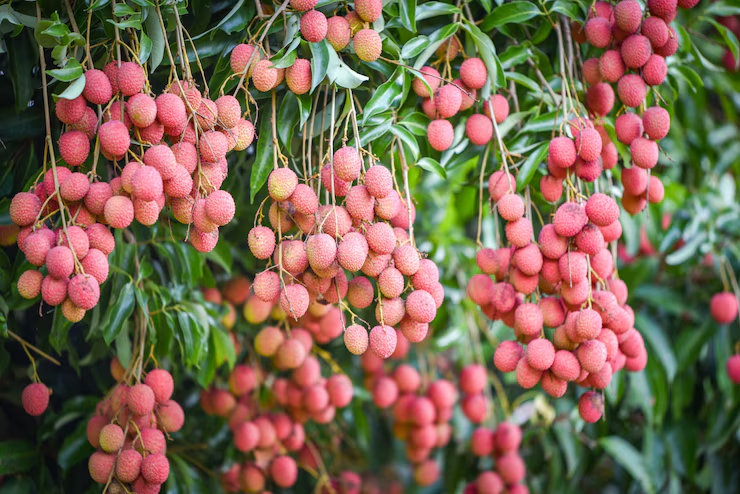
Health Benefits of Litchi
1. Boosts Immunity
Litchis contain a high concentration of Vitamin C, which plays a vital role in strengthening the immune system. Vitamin C stimulates the production and activity of white blood cells, improving the body’s defense against infections.
2. Rich in Antioxidants
Litchis are packed with powerful antioxidants, including flavonoids like quercetin, kaempferol, and rutin. These compounds help neutralize free radicals in the body, potentially reducing the risk of chronic diseases like cancer, heart disease, and diabetes.
3. Improves Digestion
Litchis contain dietary fiber, which promotes regular bowel movements and supports healthy digestion. They also help prevent constipation and other gastrointestinal disorders.
4. Supports Heart Health
The potassium content in litchis helps regulate blood pressure by counteracting the effects of sodium. Their antioxidants also reduce inflammation and improve blood vessel function, contributing to cardiovascular well-being.
5. Enhances Skin Health
The high Vitamin C content promotes collagen synthesis, which keeps skin firm, youthful, and hydrated. Antioxidants also protect against sun damage and pollution-induced aging.
6. Anti-Inflammatory Properties
Litchi extracts have shown anti-inflammatory effects in studies, which can be beneficial for conditions like arthritis and other inflammatory diseases.
7. Aids in Weight Management
Although sweet, litchis are low in calories and fat. They can satisfy a sweet craving without contributing much to daily caloric intake, making them a good snack for those watching their weight.
8. Supports Blood Circulation
Copper is essential for red blood cell production, and litchis provide a decent amount of this mineral. Regular intake can help ensure better oxygenation of the organs and tissues.
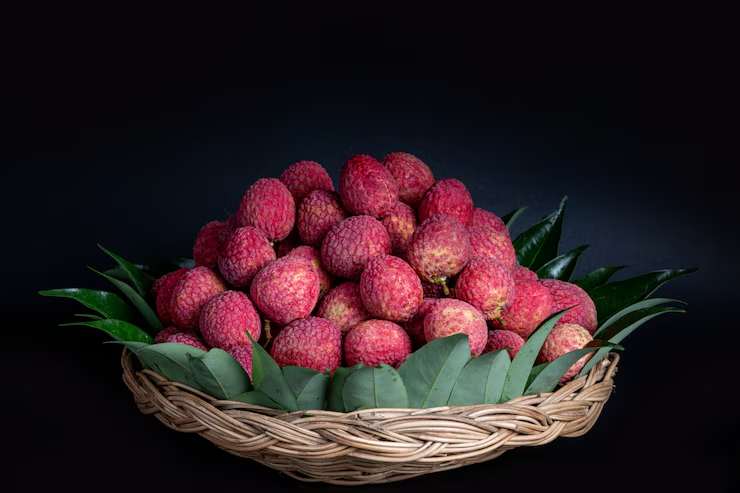
Litchi in Traditional Medicine
In Traditional Chinese Medicine (TCM), litchi has been used for centuries to:
- Treat coughs and colds
- Improve energy levels and vitality
- Support liver and spleen health
- Relieve pain from inflammation
In Ayurveda, the fruit is seen as cooling and is used to treat stomach disorders, ulcers, and other heat-related ailments.
https://sypertimes.com/mango-the-king-of-fruits-benefits-and-nutrition/
Culinary Uses of Litchi
Litchi is extremely versatile in the kitchen. Its sweet, floral notes and juicy texture lend themselves well to a variety of dishes:
Fresh Litchi
- Eaten as-is, chilled for maximum refreshment
- Added to fruit salads
- Paired with cheese and nuts on platters
Desserts
- Litchi sorbet or ice cream
- Litchi jelly or panna cotta
- Used in cakes and pastries
Beverages
- Litchi juice
- Litchi mojitos or martinis
- Litchi and mint iced tea
Savory Pairings
- Litchi-glazed chicken or shrimp
- In curries for a sweet contrast
- Asian-style salads with litchi and sesame dressing
Cultural and Economic Importance
China
As the birthplace of litchi, China holds it in high regard. It symbolizes romance and love. The famous Tang Dynasty tale of Emperor Xuanzong’s concubine Yang Guifei involves the emperor having fresh litchis delivered from South China to the capital for her.
India
India is the second-largest producer of litchi in the world. The fruit is especially popular in Bihar, West Bengal, and Uttar Pradesh, where seasonal litchi festivals celebrate its harvest.
Thailand, Vietnam, and the Philippines
These countries have also embraced litchi as a beloved fruit, using it in desserts, teas, and even herbal medicine.
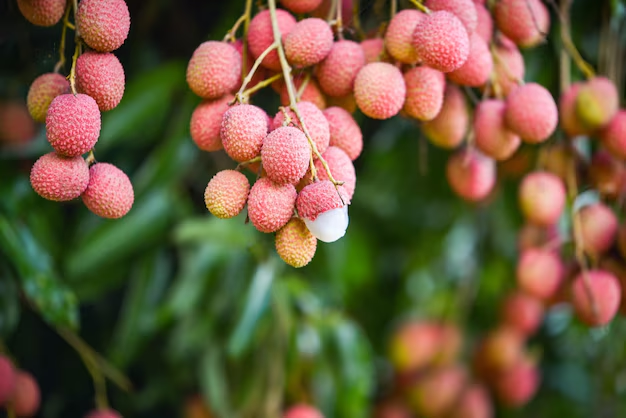
Types and Varieties of Litchi
There are over 200 known varieties of litchi worldwide. Some popular ones include:
- Hak Ip (Black Leaf) – Sweet, dark red skin, grown in China and Thailand
- Mauritius – Common in India and South Africa; small seed and high flesh ratio
- Bengal – A popular Indian variety
- No Mai Chee – Almost seedless, known for high-quality flavor
Each variety differs slightly in sweetness, flesh texture, and harvest time.
How to Select and Store Litchi
Buying Tips
- Choose litchis with bright, reddish-pink skin
- Avoid fruit with cracks or brown spots
- They should feel firm but not hard
Storage
- Refrigeration: Store in the fridge in a breathable container for up to 1 week
- Freezing: Peel and de-seed before freezing for use in smoothies and desserts
Potential Side Effects and Cautions
While litchis are largely safe, there are a few important considerations:
1. Excess Sugar
Litchis are high in natural sugars, so those with diabetes or insulin resistance should consume them in moderation.
2. Hypoglycin A and MCPG
Unripe litchis contain natural toxins, especially in children. These toxins (hypoglycin A and methylene cyclopropyl glycine) can cause a drop in blood sugar levels, leading to encephalopathy. This issue is most noted in regions of India and Bangladesh where children eat litchis on an empty stomach.
3. Allergic Reactions
Though rare, some people may be allergic to litchi, leading to itching, swelling, or respiratory issues.
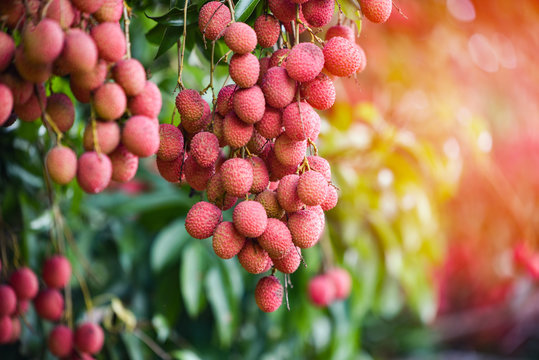
Litchi vs Other Tropical Fruits
| Fruit | Vitamin C | Calories (100g) | Unique Feature |
|---|---|---|---|
| Litchi | 71.5 mg | 66 kcal | Floral aroma, high antioxidant load |
| Mango | 36.4 mg | 60 kcal | High beta-carotene |
| Rambutan | 20.9 mg | 68 kcal | Hairy skin, similar to lychee |
| Longan | 84 mg | 60 kcal | Smaller and less floral |
Litchi stands out for its high vitamin C content and distinctive floral taste.
Sustainability and Farming
Litchi farming is largely sustainable when done in seasonally suitable climates. However, farmers are facing challenges such as:
- Climate change: Fluctuating temperatures affect flowering and fruiting cycles
- Pests and diseases: Litchi fruit borer and downy mildew
- Market price fluctuations: Affect profitability for small farmers
Efforts are ongoing to improve cultivation practices, storage, and export strategies to maximize the fruit’s potential globally.




